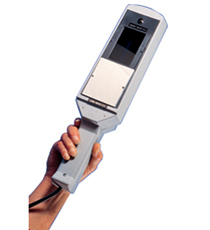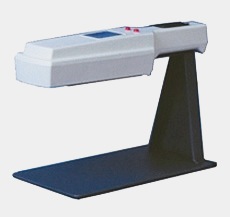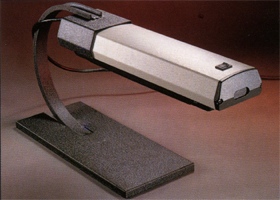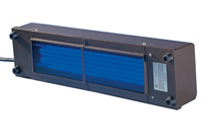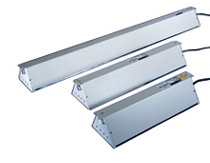C-7 Home Page
Distribution
Accessories
Display & Bench ![]() Products
& Services
Products
& Services ![]() Product Lines
Product Lines ![]() Order
Order ![]() Consignment
Consignment ![]() Library
Library ![]() Search C7.com
Search C7.com
![]() UVP Index & Overview
UVP Index & Overview ![]()
![]() Notes & Interesting Articles
Notes & Interesting Articles ![]()
![]() Products Index
Products Index
![]() Biomed
Biomed ![]() Cabinets
Cabinets ![]()
![]() Safety Gear
Safety Gear ![]() Transilluminators
Transilluminators
![]() EL Series
EL Series ![]() High Intensity
High Intensity ![]() Mini & Signature
Mini & Signature ![]() Mineralight
Mineralight ![]() PL Series
PL Series ![]() Portable & Rechargeable
Portable & Rechargeable


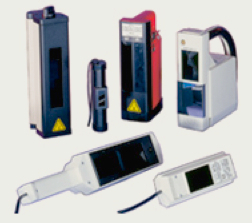 Company Seven offers the broad selection of ultraviolet (UV) sources made by UVP. When choosing a lamp for your applications keep in mind it will be the form of the lamp, its UV output, and its power requirements will most likely dictate what uses the lamp is suited for. The dimensions and weight of the lamp will often impose limits regarding how and where it may be employed too. To help our customers select from the numerous choices we characterize the differences between the in terms of:
Company Seven offers the broad selection of ultraviolet (UV) sources made by UVP. When choosing a lamp for your applications keep in mind it will be the form of the lamp, its UV output, and its power requirements will most likely dictate what uses the lamp is suited for. The dimensions and weight of the lamp will often impose limits regarding how and where it may be employed too. To help our customers select from the numerous choices we characterize the differences between the in terms of:
- Spectrum Sectors: either 254 or 302 or 365 nanometers, or a unit capable of outputting white and UV or any two or all three UV bands
- Peak Rated Output1 intensity: usually expressed as Milli or Microwatts per Square Centimeter (mW/cm2 or µW/cm2)
- Physical Arrangement: pocketable, hand holdable, desktop, or larger lamps best suited to permanent installation
- Power Source: either 115 or 220 volt AC, or DC from batteries
- Longevity: usually expressed in terms of average hours of use.
-
1. Company Seven refers to 'Peak Rated' output because in many types of UV lamps the output capacity will diminish over time owing to solarization and other aspects. This is explained in our UVP Notes & Interesting Articles applications bulletin "Solarization".
2. UV light is invisible to the human eye so it is inappropriate to use the term 'footcandles' to rate output, instead Microwatts per Square Centimeter is the appropriate term. This measurement can be accomplished by devices including our UVX Digital Radiometer. For additional information about this refer to our applications bulletins "Determining Occupational Exposure Limits to Ultraviolet Radiation" and "Measuring Black Light Intensity"
Company Seven wrote an overview about working in the ultraviolet and we host this at Ultraviolet Spectrum Primer. This illustrated article explains the ultraviolet (UV) spectrum as it applies to photographing or imaging objects in the UV and about observing fluorescence, phosphorescence, and tenebrescence. The article explains the different portions UV spectrum including UV-A (long wave), UV-B (mid) and UV-C (short wave). We also host numerous articles and lamp users guides at our Notes & Interesting Articles page.
Utraviolet Spectrum Sectors of UVP Lamps
Ultraviolent (UV) sources can be used for different purposes depending on their wavelengths within the UV range. Wavelengths are measured in nanometers (one billionth of a meter), with the UV spectrum generally falling between 100 and 380 nanometers (nm). This spectrum is divided into three categories:
|
UV Lamps In Culture and Nature
Among the more popular uses ultraviolet lamps have been the fluorescing of materials and minerals. This became a part of pop culture during the 1960's and 1970's when 'black light' sources were often used to establish a mood at concerts and clubs by fluorescing posters and other decorative items. Many stores sold black lights, posters, and other related items for the home too. Most of the sources are longwave bulbs or tubes with emissions spanning from as low as 380 to 400nm and higher into the visible spectrum.
When certain minerals or insects are exposed to the some spectra of UV then that object will fluoresce and or phosphoresce in response. Ultraviolet lamps aid people searching for Scorpions at night as the tough but flexible outer coverings of these animals will fluoresce, giving themselves away with a glow against an otherwise black background.
But most people probably first came to know ultraviolet light in a school setting when used to fluoresce minerals. An example of this is:

|
This is a really rich example of sparkling Sphalerite, with red Willemite, pink calcite, and black Franklinite. From the Sterling Hill Mine, near Franklin NJ.
Fluoresces green and dull orange in UV-C, bright orange in UV-A light, and is phosphorescent. Exhibit courtesy of Company Seven (144,577 bytes).
Click on image to see enlarged view (513,848 bytes).
Nobody Likes A Cranky Komodo Dragon
 Just as some minerals respond to ultraviolet energy, this has its place in the natural order of living things too. Natural sunlight in reasonable amounts helps people to maintain good health. The importance of proper illumination for the overall health of pets and zoo animals too is becoming better appreciated, an important component of that balance is ultraviolet.
Just as some minerals respond to ultraviolet energy, this has its place in the natural order of living things too. Natural sunlight in reasonable amounts helps people to maintain good health. The importance of proper illumination for the overall health of pets and zoo animals too is becoming better appreciated, an important component of that balance is ultraviolet.
In their natural environments some animals have evolved to thrive under exposure to the most intense sunlight. Many species of reptile depend on sunlight not only to warm themselves (they are 'solar powered' after all) but also for developing vitamin D3 and to maintain optimal health of their immune systems. It is the midwave UV-B that act on natural components of the skin of many reptiles to make vitamin D3. In the wild reptiles have adapted their behaviors to bask in the Sun, but when held captive as pets or on display reptiles do not obtain sufficient ultraviolet exposure from normal visible room light. So a properly engineered enclosure will incorporate one or more timer-controlled UV-B lamps installed overhead of the pet and focused to provide suitable but not excessive exposure. These sources are usually based on a Mercury Vapor bulb such as that built into some of our High Intensity series lamps. Since UV-B does not penetrate glass and most other transparent material used to fabricate the enclosures, the public can observe an animal in the enclosure but not suffer ill effects (sunburn, etc) from being in the proximity of the shielded ultraviolet lamp(s).
If you intend to use any lamp for your pet then you should research the subject so that you can plan on which lamp will be suitable for your enclosure. Then prior to introducing the reptile you should monitor ultraviolet levels with a Radiometer. You should also measure levels proximity of the enclosure to insure the materials shield observers.
- 4 watt
- 6 watt
- 8 watt
- 25 watt
- 40 watt
- 100 watt
- 140 watt
- High Output Grid
- the µW/cm2 ratings are not often published, and when they are then comparative working distance from the lamps to target are not always consistent; there is no standard working distance rating of these UV lamps.
- the µW/cm2 ratings vary dramatically with distance, and the relationship of µW/cm2 to distance varies dramatically.
- the longwave UV-A ultraviolet intensity measured at 2 inches from the source is 1,570 µW/cm2
- the mediumwave UV-B ultraviolet intensity measured at 2 inches is 1,839µW/cm2
- the shortwave UV-C ultraviolet intensity measured at 2 inches is 1,670µW/cm2
- choose a lamp that has multiple bulbs (two or more) so that if one burns out then even while output is diminished the exhibit can continue until a replacement bulb is installed.
- for displays that are to be illuminated by one spectrum to another (254nm to 302nm, then to 365nm for example) it may be best to rely on a rotating array, this can be more cost effective than an arrangement that relies on a timer turning lamps on and off frequently.
- for 254nm applications choose a long-life 'quartz grid lamp' based model. These can be rated for up to 20,000 hours (2.28 years!) of continuous use, and will have unlimited on/off capacity.
- some UV tubes have service ratings as short as 450 or as long as 2,000 hours, while the Mercury vapor bulb in the High Intensity series models B-100AP and B-100AP/R lamps endure for as long as about 5,000 hours. So particularly for mission critical uses (law enforcement forensics, critical experiments, prospecting expeditions) keep replacement tubes or bulbs close at hand. Order at least one spare bulb to keep on hand for every one to three lamp units in active use.
 UVP Laboratory & UV Products Catalog, the complete illustrated thirty-six page catalog, cover page illustrated at right. UVP publication UV/Lab Rev 0609. Download size is 2,761,955 bytes (in Acrobat Reader ".pdf" format).
UVP Laboratory & UV Products Catalog, the complete illustrated thirty-six page catalog, cover page illustrated at right. UVP publication UV/Lab Rev 0609. Download size is 2,761,955 bytes (in Acrobat Reader ".pdf" format).
- Ultraviolet Spectrum Primer on-line illustrated article by Company Seven explaining the ultraviolet (UV) spectrum particulary as it applies to photographing or imaging objects in the UV. The UV-A, UV-B and UV-C are described. The article is supported with color images taken of subjects in natural light then taken in the UV shown for comparison and to illustrate fluorescence, phosphoresence, and tenebrescence. Imaging gear is reviewed including: UV sources, special microscopes and lenses (Nikon UV-Nikkor / UV-105 F4.5, Zeiss Hasselblad UV-Sonnar, etc.), films and filters, and CCD imaging systems. Content copyright Company Seven and respective contributors.
- We also host numerous related articles including applications bulletins, transmission spectra data, and products user guides at our Notes & Interesting Articles index page.
In Security Applications
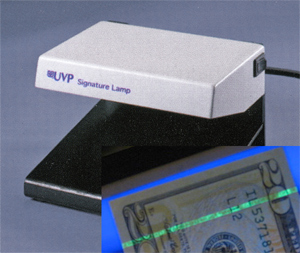 When used in security applications then an ultraviolet lamp may be used to detect security features or fraud of items including currency, credit cards, Passports. The ultraviolet may cause built in devices or logos to appear that might otherwise be invisible to the naked eye. Or chemicals or bleach used to alter documents may fluoresce giving away the perpetrator of the fraud.
When used in security applications then an ultraviolet lamp may be used to detect security features or fraud of items including currency, credit cards, Passports. The ultraviolet may cause built in devices or logos to appear that might otherwise be invisible to the naked eye. Or chemicals or bleach used to alter documents may fluoresce giving away the perpetrator of the fraud.
For example consider how the US Treasury Department has gradually been updating America's paper currency with higher technology features to defeat counterfeiting. Some of these devices are incorporated in paper fibers that are not obvious to the naked eye under ordinary light but that fluoresce under black light (long wave) sources. When the currency is examined under longwave fluorescent light then a security ribbon embedded to the left of the portrait of President Benjamin Franklin on the $100 bill fluoresces red, the thread to the right of President Ulysses Grant on the $50 note fluoresces yellow/orange, while the thread on the left side of the portrait of President Andrew Jackson on the $20 bill fluoresces green, the thread of the $10 bill with President Alexander Hamilton is red, and that of the $5 bill with President Abraham Lincoln is blue. Even though the fluorescence intensity of the security threads appears to decrease with use and handling, the security ribbon emission bands are wide and clearly distinguish each bill.
Right: The UVP Model SL-2M Signature Lamp facilitates the detection of fluorescence in currency, credit cards, identification badges.
Show here illuminating the security strip of a US $20 note (32,208 bytes).
The security thread is the only component of authentic U.S. currency that will fluoresces under black light. If the ink, the paper, or other feature fluoresces, then the bill is a counterfeit or has been altered.
In Process/Quality Control Applications
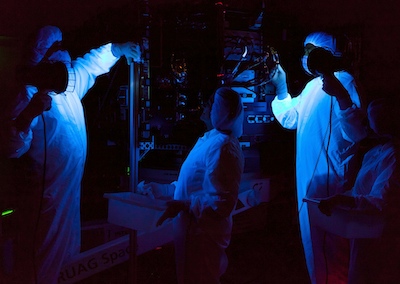 When used in applications including manufacturing, assembly or in other process control functions then an ultraviolet lamp as simple as the 'Black Light' may be used to detect leaks of some fluids, tags or other markers that should be addressed at some steps of the process. UV lamps can help to reveal certain contaminants in manufacturing process, some that may be residue from the raw materials used to create the product or the fluorescing components may have been introduced along the way of the process by the manufacturer to better track the progress of the process; how well something has been mixed or blended for example. The fluorescing components may be benign and left in to become a part of the final product, or the fluorescing components may need to be filtered out or removed along the way at some stage of the process.
When used in applications including manufacturing, assembly or in other process control functions then an ultraviolet lamp as simple as the 'Black Light' may be used to detect leaks of some fluids, tags or other markers that should be addressed at some steps of the process. UV lamps can help to reveal certain contaminants in manufacturing process, some that may be residue from the raw materials used to create the product or the fluorescing components may have been introduced along the way of the process by the manufacturer to better track the progress of the process; how well something has been mixed or blended for example. The fluorescing components may be benign and left in to become a part of the final product, or the fluorescing components may need to be filtered out or removed along the way at some stage of the process.
For example the ultraviolet lamp can reveal wire bundle fasteners or other temporary restraining straps so that they readily appear to the naked eye under UV light. These devices might otherwise be invisible or indistinguishable to the naked eye under normal room light. In the preflight preparations as shown in the image at right, there were several tags remaining that should be removed prior to flight; these fluoresce red or green under inspection with Black Light lamps.
Right: In a Clean Room prior to clearing for flight, technicians employ hand-held UV
UVP Lamp Designations
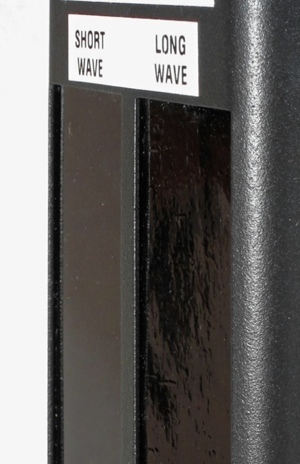 Each UVP lamp bears a label that indicates its designed working spectrum(s), the model number, and serial number for ready identification. The model letter scheme for the lamps models including 'Mini', 'Pen Ray Field', 'PL', '3UV', 'EL', 'Mineralight', 'Display' and 'Bench' series indicate their designed wavelength with the following letters:
Each UVP lamp bears a label that indicates its designed working spectrum(s), the model number, and serial number for ready identification. The model letter scheme for the lamps models including 'Mini', 'Pen Ray Field', 'PL', '3UV', 'EL', 'Mineralight', 'Display' and 'Bench' series indicate their designed wavelength with the following letters:
-
365nm Long Wave (UV-A) = L
302nm Medium Wave (UV-B) = M
254nm Short Wave (UV-C) = G or S
Right: Some UVP model lamps such as the UVSL-26P shown at right provide multiple wavelengths, here both short wave 254nm and long wave 365nm illumination. Note how the long wave filter element has a textured appearance compared to the smooth surface of the short wave filter, this is normal (52,976 bytes).
Click on image to see enlarged view (136,930 bytes).
Some lamps bear the 'BLB' (UVL-23, ML-49 lamps for example), these models incorporate a black light filtered tube that emits at 365nm filtered and higher into the visible spectrum.
These model designation schemes may not apply to the 'B-100', 'Signature', and 'Rare Gas' series lamps.
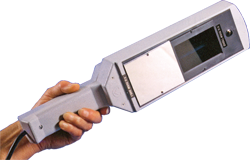 The UVP Split-Tube ultraviolet lamps (models including the UVGL-55 and UVGL-15) emit two wavelengths of ultraviolet light each. The tube in each lamp is made so that while the entire tube is powered on, one half fluoresces to provide 254nm output while the other half of the tube will fluoresces to provide 365nm illumination. The lamp filter panel is partitioned into two panes with a metal cover that the user can position over either side of the filter element, in this way it blocks either source to allow only one wavelength to pass.
The UVP Split-Tube ultraviolet lamps (models including the UVGL-55 and UVGL-15) emit two wavelengths of ultraviolet light each. The tube in each lamp is made so that while the entire tube is powered on, one half fluoresces to provide 254nm output while the other half of the tube will fluoresces to provide 365nm illumination. The lamp filter panel is partitioned into two panes with a metal cover that the user can position over either side of the filter element, in this way it blocks either source to allow only one wavelength to pass.
Left: UVP Model UVGL-55 PL Series lamp showing the metal filter blocker with one of the two filter panels remaining exposed (49,452 bytes).
To replace the lamp of a Split Tube model lamp one need order only the one UVP tube since these lamps do not rely on a separate tube for each wavelength.
Peak Rated Output
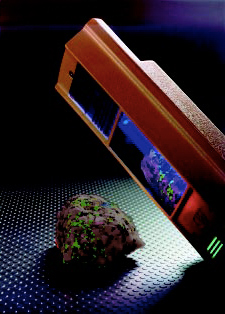 UV lamps are most commonly marketed with their ratings listed in terms of watts, or current draw. The UVP lamps tend to be rated at either:
UV lamps are most commonly marketed with their ratings listed in terms of watts, or current draw. The UVP lamps tend to be rated at either:
Wattage ratings alone can be a somewhat misleading indicator since this specification alone does not always correlate to the UV output of the lamp. Instead, UV lamp output ratings are more accurately expressed as in terms of Microwatts per Square Centimeter at a set distance.
Right: simulation of a UVP lamp illuminating a mineral sample with longwave UV-A tube on, then with both longwave and shortwave UV-C on.
Mouse over the image to see the changing effect.
To add more confusion:
For example the published data for the High Intensity series B-100AP 100 watt, 365nm longwave portable lamp specifies an intensity of 21,700 µW/cm2 at 2 inches from the object or 8,900 µW/cm2 at 10 inches to target. The self-ballasted B-100SP is a 140 wattm 365nm longwave portable lamp that produces an intensity of some 11,600 µW/cm2 when 2 inches from the object, or 5,000 µW/cm2 at 10 inches to target. The more compact, hand held R-52G Mineralight® quartz grid lamp compares at 1,250 µW/cm2 2 at six inches.
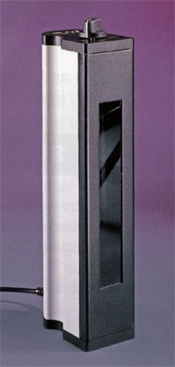
|
The output intensity of the ultraviolet emitted from a multi-wavelengths lamp, even when each tube that lamp has the same wattage rating, will vary with wavelength.
For example consider the 3UV™ Multi-Wavelength series lamps. Each of the 3UV™ series lamps incorporate three tubes, one tube to emit each ultraviolet wavelength (254, 302, and 365nm). The lamp has a mechanical manually operated tube rotating mechanism so when the power switch of the 3UV™ lamp is turned on then the tube in position nearest the filter illuminates. As the rotary dial is turned the tube is moved out of position and simultaneously turns off, as the next tube comes into position by the filter it turns on. Left: UVP 3UV™ Multi-Wavelength lamp, note the rotary dial at the top. In the case of the model 3UV-38 each of the three tubes is rated at 8 watt current draw, yet note how the intensities vary: The 3UV™ series lamps each incorporate three tubes, one tube of each UV wavelength (254, 302, and 365nm), with a manually operated mechanical tube rotating mechanism. When the 3UV™ lamp is turned on then the tube in position by the filter turns on. As the manually operated rotary dial is turned the tube is moved out of position and simultaneously turns off, as the next tube comes into position by the filter it turns on. For greater UV illumination effect or for coverage of larger areas some lamps incorporate two or more bulbs. You may array several lamps to provide for greater effect too, this can provide an added benefit of more uniformly illuminating a target from several angles. For imaging applications (not for direct viewing without safety precautions) some of our customers employ a Transilluminator (such as models we sell to illuminate gels) as back-lighting. UVP observing cabinets feature a removable bottom panel so that a Transilluminator may be attached, or this may be built into custom cabinet installations.
|
Options for Pen-Ray® lamps include: phosphors to enhance specific wavelengths, or jackets to mask higher or lower wavelengths.
When you need to know the output of a system then please inquire.
Physical Arrangement
The form of the lamp, its size, weight, and its power source will often impose limits about how and where it may be employed. The lamp may be portable operating from battery power and able to be hand carried, or the lamps may be much larger (up to 49.6 inches) and heavier (up to 20 lb.) units best suited for installations into cabinets. We characterize the degrees of portability as: pocketable, compact, handheld, desktop, and display.
UV sources may be as compact and narrow as the pocketable UVP Pen-Ray® Field Pack, a corded compact pen size lamp with a battery pack containing a 9 volt battery. Pen-Ray® lamps are narrow (typically 0.375 inch / 9.5mm wide) low pressure, cold cathode UV lamps made of double bore quartz tubing. This design allows the electrodes to be positioned at one end of the lamp providing easy access into small apertures. Depending on the lamp characteristics, primarily the lighted length (from 0.75 in. / 19.1mm up to 9.0 in. / 228.6mm), the power requirement to the lamp can range from 2 to 20 watts and produce from 40 µW/cm2 to over µW/cm2. Pen-Ray® lamps incorporate gasses including Mercury, or Argon, Krypton, Neon, Xenon, and Neon-Mercury.
At first glance the UV element of a lamp may resemble a conventional fluorescent fixture with two or more tubes, this is the case of the UVL-225D Mineralight® for example. Or the lamp may be long and slim such as the BL-15, a 20 inch (51cm) long lamp resembling a single fluorescent tube; this model is well suited to reaching into areas of automobiles permitting UV inspection for leaks.
The lamp may have a comparatively wider profile when it incorporates a Grid element. Grid lamps are mercury photochemical lamps with glass tubing bent back and forth to form several parallel bars, typically in either a rectangular or square form. They are designed for applications where shortwave 254nm UV energy is needed. The Grid Lamp is molded so that it can concentrate the energy into the specific area required. The illumination provided is uniform across the gird; without hot spots or diminished areas of output. And these generate less heat that a comparable coverage tube array. Their comparatively high power output combined with their longevity makes these lamps an idea choice for illuminating displays over a long term, curing epoxies, removing trace amounts of organic contaminants, electronic component cleaning, ozone generators, erasing Eproms and other scientific and environmental uses. A Grid element may require up to five minutes of to reach its full output capacity.
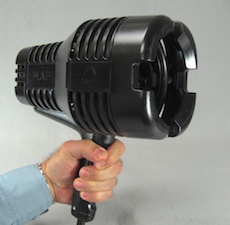 |
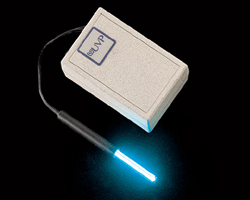
|
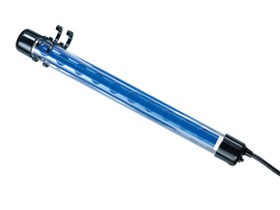 |
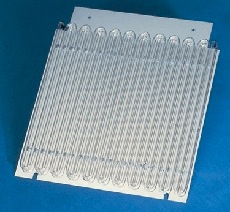 |
AC powered lamps may be used in the field from a portable AC power generator or when connected to a DC to AC power converter powered by a battery pack or solar array. The power converter must be of a high standard, and the power pack must provide a suitable capacity (Amp-Hours) for the intended mission. And so in this sense a desktop or handheld AC lamp could be considered field portable. The power cord for some 220 volt lamp models includes a two prong male plug, the wall outlets vary from country to country so in some 220 volt countries you may need to bring a wall plug adapter. The 220 volt lamp may be charged in the USA when provided with a wall step-down transformer, just as 115 volt models for the USA may be charged overseas with a step-up transformer.
The arrangement of the lamp may determine the suitability of the lamp for some tasks. For example, for performing inspections under an automobile a B-100 series lamp may be preferred as this can easily be hand held and pointed to the areas of interest. These B-100 series lamps are ballasted lamps. Ballasted lamps rely on either a separate transformer ballast chassis connected to the lamp by a cord, or some incorporate a self-ballasted bulb. The ballasted lamps with an external transformer base will usually incorporate a brace upon which the lamp may be stored:
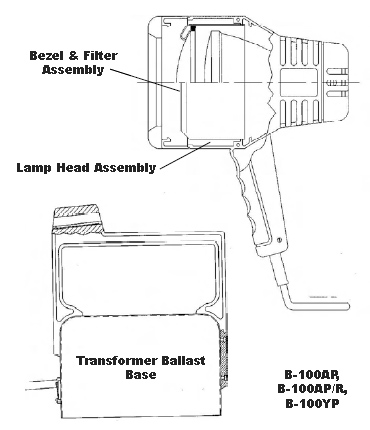 |
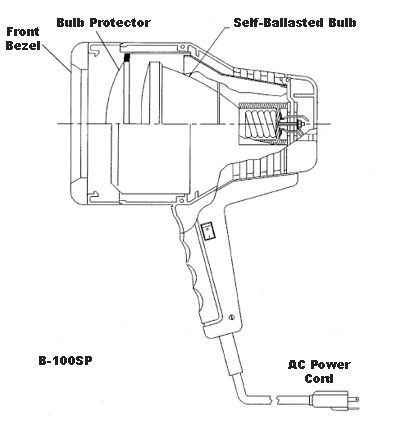 |
Power Sources
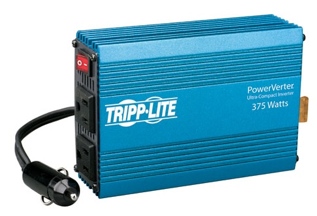 Each UVP lamp bears a label with information indicating whether it is designed to operate from internal battery power, or from 115 volt or 230 volt AC wall current. AC power may be obtained from common wall mains, or from a portable AC power generator that incorporates line filtering. For scientific applications where consistency of results is important then Company Seven recommends powering the source from a isolation transformer (or line conditioner), an AC powered device that will filter surges or spikes from the AC current. The AC powered lamps can be used in the field if suitable solar power or DC batteries are available by means of a DC to AC Power Inverter. Plan in advance considering the current requirements (draw of the lamp in watt/hour or amp/hours) so that an appropriate power inverter is selected and that suitable battery capacity is provided.
Each UVP lamp bears a label with information indicating whether it is designed to operate from internal battery power, or from 115 volt or 230 volt AC wall current. AC power may be obtained from common wall mains, or from a portable AC power generator that incorporates line filtering. For scientific applications where consistency of results is important then Company Seven recommends powering the source from a isolation transformer (or line conditioner), an AC powered device that will filter surges or spikes from the AC current. The AC powered lamps can be used in the field if suitable solar power or DC batteries are available by means of a DC to AC Power Inverter. Plan in advance considering the current requirements (draw of the lamp in watt/hour or amp/hours) so that an appropriate power inverter is selected and that suitable battery capacity is provided.
Right: Tripp•Lite 12 volt DC to 115 volt AC 375 watt power inverter, note the dual AC outlets on the side (30,502 bytes).
Some of our UVP products are portable and made to operate from DC current, this may require AA or 9 volt compact batteries for the mini and pocket lamps, or 6 volt or 12 volt powered devices that can be operated in the field from one or more batteries or from a solar array. For extended field operations you should consider buying spare batteries to keep some on charge in reserve. Company Seven sells portable higher capacity rechargeable battery packs that feature smart engineering, robust metal chassis with LCD Voltmeter to indicating voltage under load and static, and each cigarette lighter style 12 volt outlet (Positive/Hot is the tip) is circuit breaker protected by 5 amp or 10 amp breakers. Each is provided with a sophisticated charger with trickle capability and all this can be carried in the provided fitted durable nylon carrying bag:
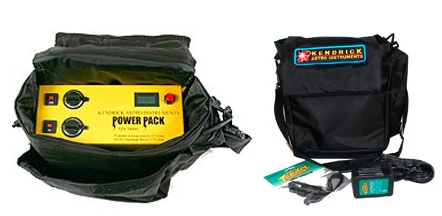 shown with provided 0.750 amp battery charger and carry case. Weight 24 lbs., Dimensions: 8.25" W x 3.5" D x 9.25" H |
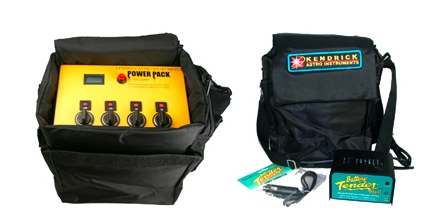 shown with provided 1.250 amp battery charger and carry case. Weight 39 lbs., Dimensions: 8.25" W x 5.5" D x 9.25" H |
For a casual session of observing or prospecting, then we recommend the lighter weight 18 AH Pack. However, for long weekends of observing or for overnight sessions then we recommend either having multiple 18 Amp Hour rated packs, or relying on the larger 33 AH Pack. In time (some years typically) when the rechargeable batteries loose their capacity, then it is a simple matter to replace the battery as these are sold separately by Company Seven and by numerous battery specialty shops.
Company Seven does not recommend operating sensitive 12 volt DC equipment from a running motor vehicle since a malfunctioning alternator or voltage regulator (as well as vehicle power demands) can produce power surges and appreciable amounts of AC power which may damage your instrument.
It is also possible to operate most portable DC units at any facility that has AC power by a Regulated AC to DC Power Supply (RPS). Be sure to order an optional suitable DC power cord to connect the lamp to the cigarette lighter style connector of the RPS. The current draw (Amps) of any AC to DC RPS should be at least 130% of the anticipated total current draw. The reputable makers recommended by Company Seven include BK Precision, Tenma. These are sold at specialty electronics supply stores or on line. For outdoors use from AC sources we recommend powering from a GFCI protected outlet.
UVP Compact, Desktop, and Portable Lamp Models
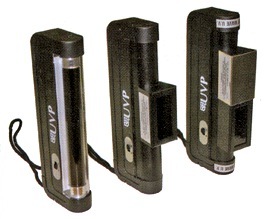 Mini-UV models UVG-4, UVSL-14P, UVL-4
|
Six Watt Models:
Eight Watt Models:
|
-
Notes:
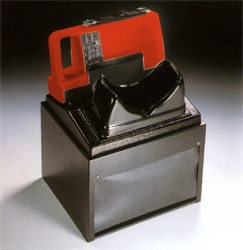
-
3. Model C-10 Observation/Imaging Cabinet accepts one 4W or 6W
C-10P Observation/Imaging Cabinet accepts one portable rechargeable 6W lamp:
C-10E4 Observation/Imaging Cabinet holds any one EL Series 4W lamps: 3UV-38, UVLMS-38, UVLM-28, UVLS-28
C-10E6 Observation/Imaging Cabinet holds any one EL Series 6W lamps: 3UV-38, UVLMS-38, UVLM-28, UVLS-28
C-15G Mini Observation/Imaging Cabinet includes one UVGL-58 lamp
C-65 Observation/Imaging Cabinet holds any one or two EL Series 8W lamps: UVL-18, UVM-18, UVS-18, UVL-28, UVM-28,
4. CHR = Chromatography, ART = Art, FLI = FL Inspection, FOR = Forensics, INT = Interferometry, MIN - Mineralogy
UVS-28, UVLMS-38, UVLM-28, or UVLS-28
MRS = Monochromatic Reference Source (for optical systems or reference studies), PHI - Photometric and Fluormetric instruments,
PCR = Photochemical Reactions (curing, etc.), SEC = Security, SPS = Spectroscopic Wavelength Calibration, STZ = Sterilization
High Intensity, Display and Bench Lamp Models
BL UV Inspection Lamp:
UV Mineralight® Display and XX Bench Lamps:
|
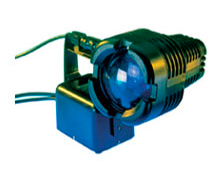 High Intensity B-100AP Blak-Ray® 365nm lamp
Company Seven can provide customers with information about lamp longevity upon request. This is usually expressed in terms of continuous hours of operation. While it is usually a simple matter to replace a UV lamp bulb and we do provide instructions with each lamp about how to do so, longevity is of a concern when the lamp is to be used installed into some hard to access location where it may be inconvenient to replace the tube. So whenever time or labor costs to change a tube or bulb are factors in the decision making process then we recommend:
Note that some types of UV sources and filters can lose some of their output capacity over time (as mentioned above). The filters on longwave lamps will last indefinitely and should never need replacing unless damaged or broken. Lamps with a BLB (Black Light) tube do not use a filter since the BLB tube itself is filtered. Shortwave and midwave filters have an average life of about 1,000 hours.
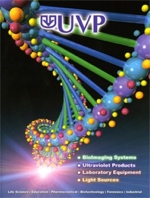
Ordering UVP Products
Company Seven stocks some of the more popular UVP lamp and cabinet products, and we accept orders for their other products by numerous means. You can also bring your UVP item to Company Seven for repair, or contact us to obtain user-serviceable items (bulbs, grids, etc.). The ways by which you may order products or parts are outlined at
Company Seven has not become convinced that on-line ordering is always beneficial for the customer, particularly when making a more complicated choice. While on-line ordering certainly is convenient and time effective for the merchant since they do not have to spend time with the customer, the customer is not always making the best choices when buying solely after reading what may be "propaganda" on line. The best ways to make the better choices are to either visit our showroom, or telephone 301-953-2000. This way you can obtain prompt and competent concise assistance which will address your particular needs and concerns.
|
||||||||||||||||||||||||||||||||||||||||||||||||||||||||||||
|
|
Contents Copyright 1994-2012 Company Seven and UVP - All Rights Reserved |


